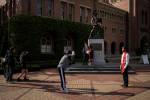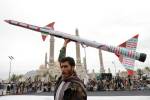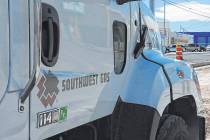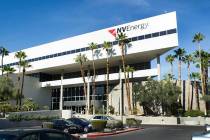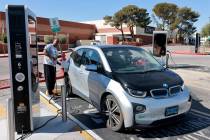NV Energy backs off coal-fired Ely Energy Center; Air Force objects to solar plant
Which is better: Fossil fuels or renewable energy?
The answer seems to be neither one, if you listen to a passel of politicians, environmentalists, military officials and power providers.
Two major area power plants representing both ends of the debate took big hits last week.
Electric utility NV Energy formally withdrew its application through the state Public Utilities Commission to build the Ely Energy Center, a central Nevada plant that would have been one of its biggest generators yet.
However, company spokesman Mark Severts noted that air permits and land applications for the project remain open through other state and federal agencies for now.
Also last week, Air Force officials urged the federal government to deny construction of a $700 million solar power plant near the service’s Nellis flight-training range, about 175 miles northwest of Las Vegas.
A Los Angeles company called SolarReserve wants to build the solar station, but Col. Howard "Dave" Belote, Nellis Air Force Base commander, said the plant could interfere with operations at the base’s testing range.
NV Energy officials said in February that they would postpone development of the Ely Energy Center until they could find commercially feasible technology for capturing and storing the carbon dioxide that burning coal releases into the atmosphere.
Developing and deploying such capabilities could take a decade, company officials said.
NV Energy notified the Public Utilities Commission of its official application withdrawal on June 15.
The $5 billion, 1,500-megawatt plant would have generated enough energy to power 900,000 homes. Its first phase was scheduled for completion in 2011.
NV Energy told the Public Utilities Commission in its application withdrawal that it still planned to build ON Line, a 250-mile transmission network originally slated to be part of the Ely Energy Center.
ON Line would connect Southern Nevada to renewable energy sources, such as geothermal plants in Northern Nevada. It would also enable NV Energy’s subsidiaries in Reno and Las Vegas to share power plants.
The Ely project proved controversial from the beginning.
NV Energy proposed the plant in 2006 amid efforts to create more in-state generating power, while at the same time diversifying its fuel base.
Most of Nevada’s power comes from natural gas-fired power plants, and natural gas is notorious for its volatile prices.
But Senate Majority Leader Harry Reid, D-Nev., and a coalition of environmentalists fought the Ely station from the beginning, decrying the effects they said the coal-fired plant would have on the climate.
The Public Utilities Commission had authorized NV Energy to spend up to $135 million by February to begin developing the Ely center, but none of those costs are included in the general rate case that goes before the commission for a decision Wednesday.
In a February article in the Review-Journal, NV Energy Chief Executive Officer Michael Yackira wouldn’t say how much the company had spent on the plant, or whether it would ask the commission to raise rates later to compensate the power company for expenses on the project.
Coal-fired plants aren’t the only source of controversy these days.
In 2007, a Los Angeles firm called SolarReserve proposed the construction of a $700 million solar thermal power plant covering two square miles near Tonopah.
But Belote said last week that the plan won’t fly, and he is urging federal government agencies to turn it down.
The Air Force’s opposition demonstrates some of the conflicts and delays that could lie ahead as renewable-energy projects search for places to put big wind turbines or solar collectors, even in Western states where the federal government is a major landholder.
SolarReserve has been negotiating with the Air Force for 18 months and already has revised its plans once to move the plant 25 miles away from the test and training range, at the Air Force’s suggestion.
The Nevada plant was supposed to be a showcase for SolarReserve: one of the largest solar plants in the world, using heat-transfer technology developed for space rockets by United Technologies.
The plant could store 16 hours of power supply, easing concerns about the ability of solar plants to provide power when it’s dark or cloudy. It would power about 50,000 homes.
Belote said in a statement Monday that locating the solar plant near the Nellis range "is incompatible with our vital national security operations." Specifically, it would interfere with radar and ground-based systems for operations involving flight testing, air warfare training and large force exercises.
Last week, he said the Air Force would tell the Interior Department’s Bureau of Land Management to reject the proposal.
SolarReserve officials "did a lot of (research) with publicly available tools," Belote said. "But when they came back for an official look the answer was, ‘Man, that’s still too close.’ And because of the sensitivity (of information), I can’t tell them why. … Unfortunately for them and us, there’s stuff on the Nevada testing range we don’t tell anyone about."
Belote suggested that SolarReserve officials try a site near Mesquite, 75 miles northeast of the base.
The Air Force has a history of balking at projects near the 2.9-million-acre flighttraining range, which makes up 41 percent of the Air Force’s total training acres. The Air Force objected to a wind turbine project at the Nevada Test Site for similar reasons.
But "we tried to make sure we had a site the Air Force wouldn’t object to," Smith said.
The company’s plan would place a lone solar-power tower below a 2,000-foot-tall mountain range.
SolarReserve has appealed to members of Congress for help.
Belote has arranged for classified briefings to explain his objections to select Senate staffers, and he has promoted the project to the mayor of Mesquite.
"Our community is very, very interested in alternative energy and the thought of being green," said Mesquite Mayor Susan Holecheck. "Historically, our economic base has been gaming and tourism."
Another solar company has proposed a project using similar technology.
Holecheck said Mesquite officials would have to study whether a SolarReserve site would interfere with plans for moving the town’s airport.
The Bureau of Land Management also would need to agree to provide land.
Contact reporter Jennifer Robison at jrobison@reviewjournal.com or 702-380-4512.
Review-Journal Keith Rogers contributed to this report. The Associated Press contributed to this report.




